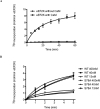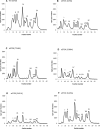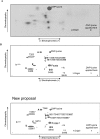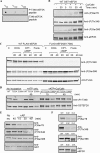Identification of autophosphorylation sites in eukaryotic elongation factor-2 kinase
- PMID: 22216903
- PMCID: PMC3286862
- DOI: 10.1042/BJ20111530
Identification of autophosphorylation sites in eukaryotic elongation factor-2 kinase
Erratum in
- Biochem J. 2012 Apr 1;443(1):328
Abstract
eEF2K [eEF2 (eukaryotic elongation factor 2) kinase] phosphorylates and inactivates the translation elongation factor eEF2. eEF2K is not a member of the main eukaryotic protein kinase superfamily, but instead belongs to a small group of so-called α-kinases. The activity of eEF2K is normally dependent upon Ca(2+) and calmodulin. eEF2K has previously been shown to undergo autophosphorylation, the stoichiometry of which suggested the existence of multiple sites. In the present study we have identified several autophosphorylation sites, including Thr(348), Thr(353), Ser(366) and Ser(445), all of which are highly conserved among vertebrate eEF2Ks. We also identified a number of other sites, including Ser(78), a known site of phosphorylation, and others, some of which are less well conserved. None of the sites lies in the catalytic domain, but three affect eEF2K activity. Mutation of Ser(78), Thr(348) and Ser(366) to a non-phosphorylatable alanine residue decreased eEF2K activity. Phosphorylation of Thr(348) was detected by immunoblotting after transfecting wild-type eEF2K into HEK (human embryonic kidney)-293 cells, but not after transfection with a kinase-inactive construct, confirming that this is indeed a site of autophosphorylation. Thr(348) appears to be constitutively autophosphorylated in vitro. Interestingly, other recent data suggest that the corresponding residue in other α-kinases is also autophosphorylated and contributes to the activation of these enzymes [Crawley, Gharaei, Ye, Yang, Raveh, London, Schueler-Furman, Jia and Cote (2011) J. Biol. Chem. 286, 2607-2616]. Ser(366) phosphorylation was also detected in intact cells, but was still observed in the kinase-inactive construct, demonstrating that this site is phosphorylated not only autocatalytically but also in trans by other kinases.
Figures







References
-
- Ovchinnikov L. P., Motuz L. P., Natapov P. G., Averbuch L. J., Wettenhall R. E., Szyszka R., Kramer G., Hardesty B. Three phosphorylation sites in elongation factor 2. FEBS Lett. 1990;275:209–212. - PubMed
-
- Price N. T., Redpath N. T., Severinov K. V., Campbell D. G., Russell J. M., Proud C. G. Identification of the phosphorylation sites in elongation factor-2 from rabbit reticulocytes. FEBS Lett. 1991;282:253–258. - PubMed
-
- Carlberg U., Nilsson A., Nygard O. Functional properties of phosphorylated elongation factor 2. Eur. J. Biochem. 1990;191:639–645. - PubMed
-
- Ryazanov A. G., Davydova E. K. Mechanism of elongation factor 2 (EF-2) inactivation upon phosphorylation. Phosphorylated EF-2 is unable to catalyze translocation. FEBS Lett. 1989;251:187–190. - PubMed
-
- Drennan D., Ryazanov A. G. α-Kinases: analysis of the family and comparison with conventional protein kinases. Prog. Biophys. Mol. Biol. 2004;85:1–32. - PubMed
Publication types
MeSH terms
Substances
Grants and funding
LinkOut - more resources
Full Text Sources
Molecular Biology Databases
Miscellaneous

